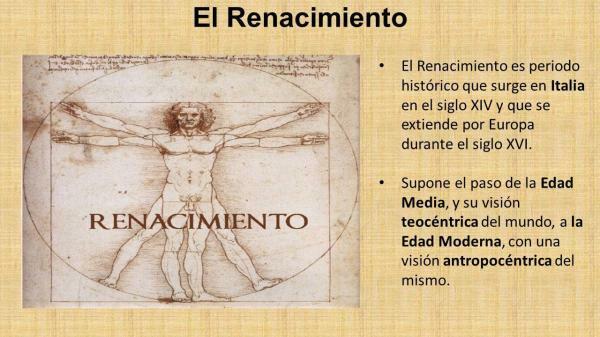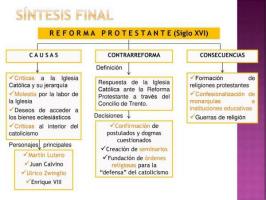The Renaissance: main characteristics

Image: Wikipedia
In this lesson from a PROFESSOR we are going to deal with a very interesting historical stage as it was The Renaissance: main characteristics. We can say that the Renaissance was an intellectual revolution that began in Italy at the end of the fourteenth century and that was characterized by the enormous apogee that the humanities had, therefore in this Renaissance summary We will give you the main characteristics to understand the revolution that this era brought with it. Keep reading and you will know all the characteristics that marked a historical and cultural period as important as the Renaissance.
We must place ourselves in the Full Middle Ages to understand the advance that the Renaissance meant for letters and science. Europe, at that time, was developing what we can call modern states, or what is the same, states / countries that have survived to this day.
Therefore we will find that in most of these Latin was no longer used to start using vernacular languages (languages that in one way or another, with their respective changes, have reached our days). In this way only the great nobles, kings and members of the Church still knew Latin.
Let's now focus on the main characteristics of the Renaissance. We are going to find 4 important characteristics at this stage:
- The "return to antiquity": it will be the moment by which the gaze is turned to the architectural forms of the past, to the formal motifs of the texts and to the old plastic tendencies. For this reason we will find the theme of classical mythology, history or even the use of symbolic elements of the past. Many of the forms of classical arts are largely known due to the compilation that was made at that time.
- Emergence of a new relationship with nature: mathematics became the main aid of art, helping to give the proportions in the figures.
- The Renaissance makes "man" the measure of all things: the artist ceases to belong to the guilds and to not be known by anyone as was the case in the past and is called a creator and will have a new position within society. To do this, they will begin to study anatomy in order to reflect the man and the environment as accurately as possible.
- Artistic patronage: It will be the highest classes that finance the works of said artists, being able to name among the most important to the family of Florence par excellence, the Medici or even the Popes of Rome, who were great patron.
As we have already mentioned previously, the Renaissance in the beginning was merely humanistic although, with the passage of time, we will find that it affected other aspects of life.
In this other video of a PROFESSOR we tell you what is the renaissance, in a class with which you can delve into this important moment in our history.

Image: SlidePlayer
We have to say that, although the authors of that moment and other contemporary authors have wanted to give the idea that the Renaissance is another stage different historical, we are still in the Middle Ages and, specifically in the period known as the Low Middle Ages, that is, at the end of the period medieval.
Recovery of Latin
In this Renaissance summary we have to talk about the Latin recovery on the part of the humanists as an official language, that is, they saw the vernacular languages as an aberration and typical of the barbarians. Therefore they believed and saw themselves in the duty of recovering Latin as a means of communication.
Thus we will find a series of authors who began to write in Latin the works that had begun to write in vulgar languages and re-translate or copy from old Roman and Greek texts the knowledge forgotten. For this, there were many who did not hesitate to enter the convents and monasteries to recover the documents from the old libraries and be able to copy them.
Appearance of the printing press
An invention that occurred at that time was the printing press, this machine was created by Johannes Gutenberg around 1444. Which helped to spread this trend, since more copies of the copies in Latin could be made, thus reaching more parts of Europe and in less time.
Review of the classics
By studying the classical texts again, we will find that new discoveries were made and ideas were collected from ancient Greek and Roman authors, about science ...
Changes in architecture
In the same way, the architecture also changed, giving a return to the old ruins that still remained in Europe and more specifically in Italy (where the movement originated). Hence, the architecture that began to be made had traits of the ancient classical civilization, which humanists thought they could recover and re-establish.
Anthopocentric mindset
Thus, the plastic arts also underwent a series of changes, moving to much more colorful works and beginning to deal with non-religious themes such as the recovery of mythological themes. It is, therefore, a period in which the mentality of man goes from being theocentric (that is, that the center of the universe and life is God) to anthropocentric, in which the center of everything is occupied by the human being.
Although in this summary of the Renaissance we have talked about the importance of the humanities, the idea of these authors to try to rescue Latin as an official language was an authentic failure.
This was due in large part to a nationalistic feeling that was beginning to emerge, in which the great monarchies or princes wanted to make their states the strongest and most consolidated and, for this, they needed their own language. It was for this reason that these languages were increasingly being used for all kinds of writings, the language of the Italian peninsula being practically relegated to the Church.
However, painting, sculpture and architecture did go through the filter of these monarchies, although in each place the Renaissance was received in one way or another, that is, with small changes.



